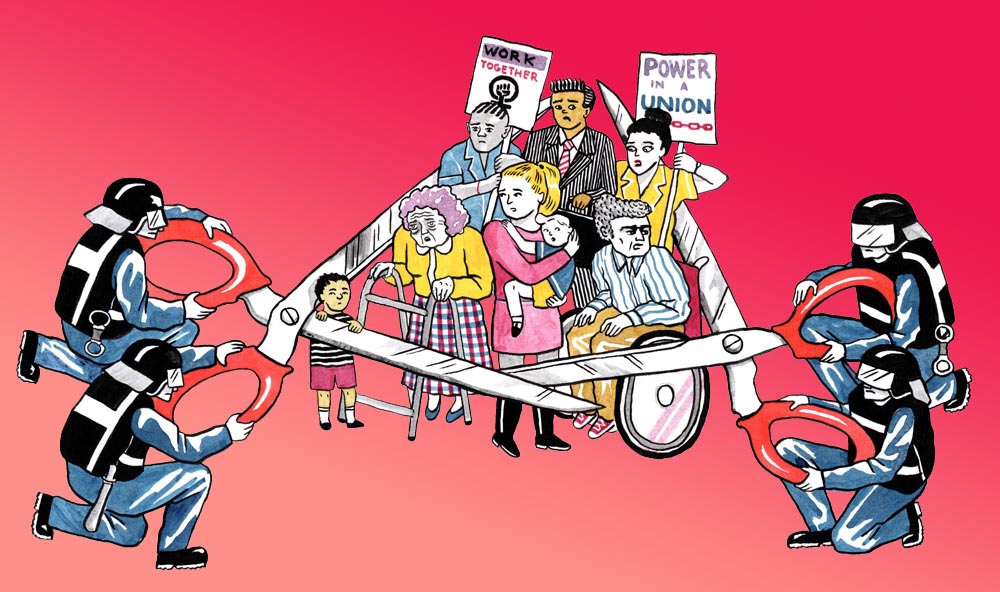The State of Austerity
Anyone with weak nerves or a heart condition should look away now. For here is an exciting fact. In the fiscal year 2017–18, government spending will dip slightly below 40%.
This isn’t actually very exciting. Slightly below forty percent of GDP is within the normal range of public spending in Britain. Surely, with initial planned cuts of 19% across all departments and more following, the state should be shrinking a lot faster than it is. But even with brutal cuts in welfare, the relative cost of social security has increased.
Why? To answer that, we have to debunk the austerity myths. But we have to go much deeper. We have to rethink the state from the bottom up.
Not about the ‘small state’
The Prime Minister promised us a lean state. His reasoning was that for Britain to be competitive in the global economy, it had to relieve the private sector of the burden of taxation and free more private capital to invest.
The neoliberal state says it is down-sizing, constantly—eviscerating itself, slashing its own wrists, trying to get out of people’s way since it was a cheeky glint in Hayek’s eye. Of course, the second there is any serious contest, any major conflict of interests, the state appears, settling matters with sudden, maniacal violence. Ninja-like, it conceals itself in the sinks, recesses, dark corners and perimeters, emerging for swift bouts of exemplary force, only to retreat from view just as quickly.
This is not how it really works. The fables about getting the ‘nanny state’ off our backs are for the chumps. A core tenet of neoliberal doctrine has always been that the character, not the volume, of state activity is what must change. Throughout the neoliberal period, the size of the British state has not shrunk at all. Two things have happened instead.
First, the institutions of the state have been re-formatted in order to make them more like ‘the market’. There is no such thing as ‘the market’, but the basic principles of competition, pricing and cost-capping have been implemented throughout the public sector. The technical discourse underpinning these changes is known as ‘public choice economics’, and key theorists of this ilk such as William Niskanen were forced upon the civil service bureaucracy as part of reforming the the state. One effect of this, intended by neoliberals, was to reduce the democratic capacity of the state by shifting more of its functions away from democratic control to oversight by private sector officials, quangos and private companies. In the Seventies, it was said, a ‘crisis of democracy’ had taken place. The state had been overloaded with demands from too many active and mobilised constituencies, thus losing its ability to govern. This was the neoliberal answer.
Second, state apparatuses have been redeployed to incentivise ‘entrepreneurial’ action and discipline collectivism and non-market transactions. This of course required the expansion of repressive institutions, initially to control strikes and protests (police), and later to punish a wider range of behaviour considered harmful to viable entrepreneurial communities (ASBOs, anti-terror laws and prison building). But it also included a more subtle reorganisation of other forms of spending. Consider workfare. This costly bureaucracy exists to keep the recipients of welfare in the habit of working. It thus, according to neoliberal orthodoxy, bolsters their human capital and their viability as future employees.
So this is the first lesson. Neoliberalism isn’t about a small state. It is about the competition state. Cuts are a weapon not the goal. In every austerity project implemented since Chile and New York in the mid-1970s, the end result is not a smaller state, but weaker labour, less democracy, more authoritarianism and a hard-nosed culture of competition.
Fiscal crisis is built into modern states
If spending cuts are not the objective, is the fiscal crisis an illusion? Not exactly. True, there is no ‘overspend’: we have endured decades of the neoliberal straitjacket. Labour did nothing to reverse this and was in fact more absurdly punctilious about securing a ‘balanced budget’ than previous administrations. Still, there is more to this than myth.
Over decades, successive governments have attempted to bring public spending under control. Thatcher in the UK, Reagan in the US, Chirac and Juppe in France, Clinton in the US, Chretien in Canada, and later Schroeder in Germany, all attempted to ‘streamline’ government services, and cut taxes on business. This was justified by the ideology of ‘globalisation’ - to be competitive in a more integrated world economy, national states had to spend less on ‘unproductive’ welfare recipients and promote ‘enterprise’. The reality was more complex. Leading capitalist economies were declining in productivity and growth, while investment was shifting to less profitable service industries. The population was becoming older and thus had more dependent citizens. States can race to counteract these trends with cost-cutting, but they’re up against a stubborn fact: fiscal crisis is built-in to modern states.
In 1973, just as the post-war social compromise was falling to pieces, the sociologist James O’Connor identified a long-term “tendency for government expenditure to outrace revenues”. He said this was rooted in two basic functions facilitated by the state: accumulation and legitimation. The first included measures that benefited the economy, such as stimulus spending, tax breaks, bailouts, nationalisations, shutting down failing businesses, building new infrastructure and so on. The second involved the organisation of consent through the mediation of class struggles, the creation and maintenance of the shared cultural and social space within which production takes place, and the deployment of material incentives to encourage integration. For O’Connor, the costs of these functions tended to rise beyond the ability of the state to recover revenues.
This was ultimately rooted in a conflict between democracy and capitalism. No matter how many economic functions the state takes on, the control of profits remains in private hands, and the state cannot take control of these profits in the interests of carrying out its legitimation functions without seriously curtailing capitalist power.
This makes perfect sense. Yet one cannot infer state behaviour from various ‘functions’ that it supposedly has to perform. A lot of what states do is dysfunctional. And in fact, all accumulation functions can in principle be carried out in the private sector. Why do states even bother to take on economic functions? Why don’t they just cut the bureaucracy out entirely? Part of the answer, as Mariana Mazzucato has shown, is that private capital is dependent upon the innovation and dynamism of the public sector. Some types of accumulation function aren’t profitable enough, or are too risky, for private firms to take them on. Yet, neoliberal states often fail to take on essential accumulation functions, even where the private sector neglects them. Another reason might be that some functions are too important to be trusted to a narrow sector of capital devoted to short-term profits. But the case of US healthcare reminds us that all kinds of irrational and excessively costly privatised arrangements can be tolerated for a long time. Dysfunction is normal in capitalist states.
Ceci n'est pas un état
There is no such ‘thing’ as ‘the state’. In a way, we all know this. The police truncheon is a tangible object, and the cop wielding it is a person: the state is neither. But it’s a lot harder to figure out exactly what the state is.
What we experience as ‘the state’—traffic wardens, hospitals, death certificates, statutes, local elections, binmen, job centres, arms fairs and so on—is itself just a series of outcomes. Rather than starting with these things and trying to work out what their internal coherence is on the basis of their functionality to the system, we should inquire as to the processes of which they are outcomes. Think of elections. These are themselves the outcome of a prolonged class struggle in the UK, beginning with the English Civil War and culminating in successive Reform Acts which eventually enfranchised the entire adult population. Hospitals fall into a similar category, inasmuch as the NHS is the outcome of a particular type of social democratic class politics. Much of the welfare state is the product of other types of political conflict, such as feminist or anti-racist struggle. These are gross simplifications, but they illustrate the point. The processes which go into the making of the state are political struggles structured by antagonistic social relations.
The state can thus be understood as the outcome, or the “material condensation” as Nicos Poulantzas put it, of the balance of class and political forces in a society. And if the state’s format, personnel and institutional linkages, all tend to support the existing patterns of domination in a society, it is because that is the accumulated outcome of centuries of political struggle. But the institutions that result from these processes are subject to ongoing struggles both internally and externally. Given this, whatever ‘functions’ the state carries out, it does so in a permanently fluctuating and unstable field of forces. Any ‘line’ that emerges within the state arises from the interaction of opposing forces.
Thus, when the state carries out legitimation and accumulation functions, it doesn’t simply read off its objectives from whatever is ‘functional’ to the system. What is good for the system is rarely transparent and always contested. Rather, it organises a series of compromises between the dominant and dominated, and between different elite sectors. These compromises are expressed not just in institutional outcomes, but also in the ideological and technical discourses of the state. Such compromises overwhelmingly favour the dominant classes, but are represented as reflecting the ‘national interest’. And they are subject to constant revision as the balance of forces shifts due to recession, a rightward lurch, or a collapse in trade unionism.
Understanding it like this helps us to better understand the permanent fiscal crisis of modern states, and the austerian answer to it.
Capitalism vs democracy
The dilemma of modern states is this. As the core economies become less productive and profitable over the long term, businesses become less willing and able to fund interventionist states. At the same time, however, as economies become more crisis-prone, and as these crises get deeper, the need for state intervention increases. Bailouts, unemployment benefits, public-private scams, all cost money. States can try to cut costs, but political opposition may prevent this. They can borrow against future growth, but only if such borrowing is part of a viable growth strategy. That again is subject to the contest of opposing political forces.
And this is where the austerians come in. They represent the neoliberal faction of the capitalist class, and they know that their problem is democracy. They may not use exactly this language, but they know that the egalitarian and collective ends of democracy are at odds with the competitive and hierarchical ends of capitalism. Their objective is to limit the claims of democracy on capitalism, and the opportunity to do so is rare. And they know that a crisis presents opportunities for the left to expand the democratic constraints on capitalism. This is why they ‘never let a serious crisis go to waste’, never miss an opportunity to disrupt the continuum of democratic negotiation on their own terms, and revoke and reorganise the compromises through which legitimacy was previously secured.
The fiscal crisis is their cue, but their objective is bigger. They haven’t forgotten that the crisis is one of capitalism and they wage war in and through the state to address that crisis on terms favourable to capital. That means changing the relations of forces that are condensed in the state, retooling the state to meet business needs. It means less democracy, more capitalism.

Get it here



